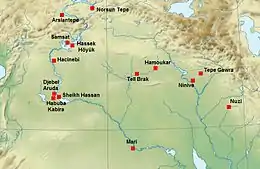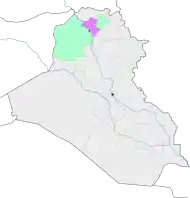Tepe Gawra
Tepe Gawra (Kurdish for "Great Mound")[1] is an ancient Mesopotamian settlement in the Mosul region of northwest Iraq that was occupied between 5000 and 1500 BC. It contains remains from the Halaf period, the Ubaid period, and the Uruk period (4000–3100 BC). Tepe Gawra contains material relating to the Halaf-Ubaid Transitional period c. 5,500–5,000 BC.
 Shown within Iraq | |
| Location | Nineveh Province, Iraq |
|---|---|
| Region | Northern Mesopotamia |
| Coordinates | 36°29′44″N 43°15′37″E |
| Type | tell |
| Site notes | |
| Excavation dates | 1927, 1931, 1932 |
| Archaeologists | E.A. Speiser |

History of archaeological research
A brief exploratory dig was performed by Austen Layard before 1850.[2] The site was formally excavated in 1927, 1931, and 1932 for a total of 8 months by archaeologists from a joint expedition of the University of Pennsylvania and the American Schools of Oriental Research, led by Ephraim Avigdor Speiser.[3]
In 2001, Mitchell Rothman reanalyzed the data from previous excavations that did not use precise stratigraphic techniques. He considerably clarified the stratigraphy of the site.[4]
Tepe Gawra and its environment

Tepe Gawra lies near the ancient site of Nineveh, 2 miles (3.2 km) from Khorsabad and 15 miles (24 km) northeast of the modern city of Mosul. The tell or settlement mound at Tepe Gawra is 120 metres (390 ft) in diameter and 22 metres (72 ft) high.
Tell Arpachiyah is a contemporary Neolithic site nearby.
Occupation history

_4000_BCE.jpg.webp)
Excavations at Tepe Gawri revealed 16 levels showing that the Tepe Gawra site was occupied from approximately 5000 BC to 1500 BC. They include the earliest known temple to be decorated with pilasters and recesses. The Gawra Period (3500–2900 BC) is named for the site.
Earliest use of gold
According to Daniel Potts, the earliest evidence for gold or electrum use in the Near East comes from Ur and Tepe Gawra; a few small artifacts, such as wire and beads, have been found at these sites. At Tepe Gawra, the use of gold and electrum continued into the Early Dynastic period, starting about 2900 BC.[5]
Several objects from levels 12 to 8 (mid-fourth to early-third millennium BC) at Tepe Gawra were made of arsenical copper, which is quite early for Mesopotamia. Similar objects are also found in Fara (Shuruppak), also dating from Jamdat Nasr period.[6]
Chronology
See also
References
- http://www.encyclopedia.com/reference/encyclopedias-almanacs-transcripts-and-maps/tepe-gawra
- A. H. Layard, Nineveh and Its Remains, John Murray, 1849
-
- E. A. Speiser, Excavations at Tepe Gawra 1, University of Pennsylvania Museum of Archaeology and Anthropology, 1935.
- Arthur Tobler,. Excavations at Tepe Gawra 2, University of Pennsylvania Museum of Archaeology and Anthropology, 1950
- E. A. Speiser, New Discoveries at Tepe Gawra and Khafaje, American Journal of Archaeology, vol. 41, no. 2, pp. 190-193, 1937
- The Expedition to Tell Billa and Tepe Gawra, Bulletin of the University Museum, University of Pennsylvania, vol. 3(2), pp. 59-66, 1931
- Developments at Tell Billa and Tepe Gawra, Bulletin of the University Museum, University of Pennsylvania, vol. 3(3/4), pp. 94-95, 1932
- Excavations at Tell Billa and Tepe Gawra, Bulletin of the University Museum, University of Pennsylvania, vol. 3(5), pp. 126-130, 1932
- Mitchell S. Rothman, Tepe Gawra: The Evolution of a Small, Prehistoric Center in Northern Iraq. University Museum Publications, 2001, ISBN 0-924171-89-8
- Potts, Daniel T., ed. (15 August 2012). "Northern Mesopotamia". A Companion to the Archaeology of the Ancient Near East. 1. John Wiley & Sons, 2012. p. 297. ISBN 978-1-4443-6077-6.CS1 maint: ref=harv (link)
- Daniel T. Potts, Mesopotamian Civilization: The Material Foundations. Cornell University Press, 1997 ISBN 0801433398 p167
- Liverani, Mario (2013). The Ancient Near East: History, Society and Economy. Routledge. p. 13, Table 1.1 "Chronology of the Ancient Near East". ISBN 9781134750917.
- Shukurov, Anvar; Sarson, Graeme R.; Gangal, Kavita (7 May 2014). "The Near-Eastern Roots of the Neolithic in South Asia". PLOS ONE. 9 (5): e95714. Bibcode:2014PLoSO...995714G. doi:10.1371/journal.pone.0095714. ISSN 1932-6203. PMC 4012948. PMID 24806472.
- Bar-Yosef, Ofer; Arpin, Trina; Pan, Yan; Cohen, David; Goldberg, Paul; Zhang, Chi; Wu, Xiaohong (29 June 2012). "Early Pottery at 20,000 Years Ago in Xianrendong Cave, China". Science. 336 (6089): 1696–1700. Bibcode:2012Sci...336.1696W. doi:10.1126/science.1218643. ISSN 0036-8075. PMID 22745428.
- Thorpe, I. J. (2003). The Origins of Agriculture in Europe. Routledge. p. 14. ISBN 9781134620104.
- Price, T. Douglas (2000). Europe's First Farmers. Cambridge University Press. p. 3. ISBN 9780521665728.
- Jr, William H. Stiebing; Helft, Susan N. (2017). Ancient Near Eastern History and Culture. Routledge. p. 25. ISBN 9781134880836.
Further reading
- P. Butterlin (éd.), A propos de Tepe Gawra, le monde proto-urbain de Mésopotamie - About Tepe Gawra: a proto-urban world in Mesopotamia, Brepols Publishers, 2009, ISBN 978-2-503-53002-4
- T. E. Davidson and Hugh McKerrell, The Neutron Activation Analysis of Halaf and 'Ubaid Pottery from Tell Arpachiyah and Tepe Gawra, Iraq, vol. 42, no. 2, pp. 155–167, 1980
- E. A. Speiser, The Bearing of the Excavations at Tell Billa and at Tepe Gawra upon the Ethnic Problems of Ancient Mesopotamia, American Journal of Archaeology, vol. XXXVI, pp. 29–35, 1932
External links
| Wikimedia Commons has media related to Tepe Gawra. |
